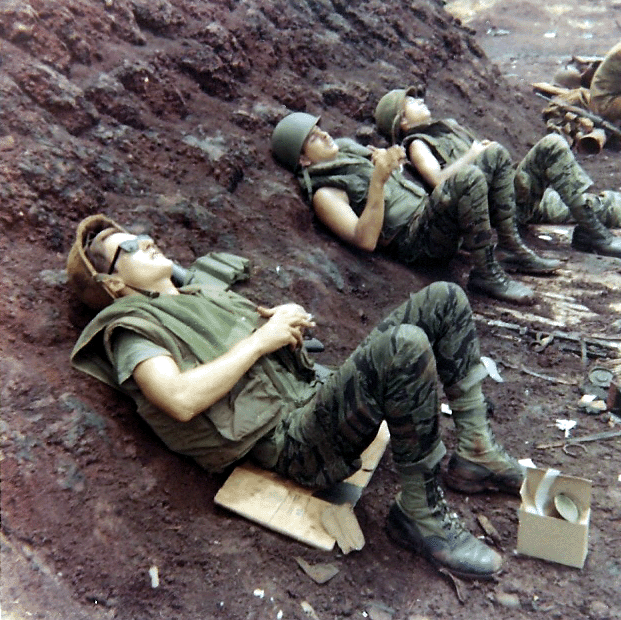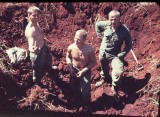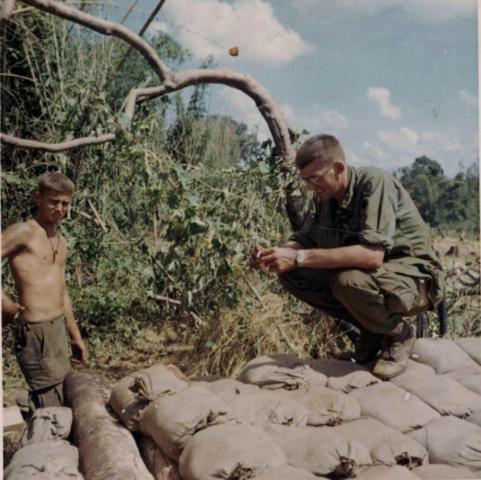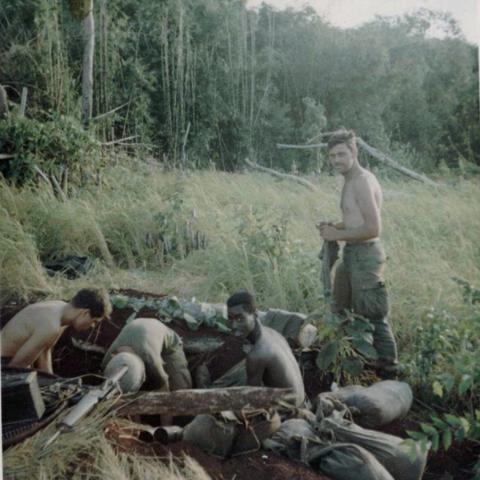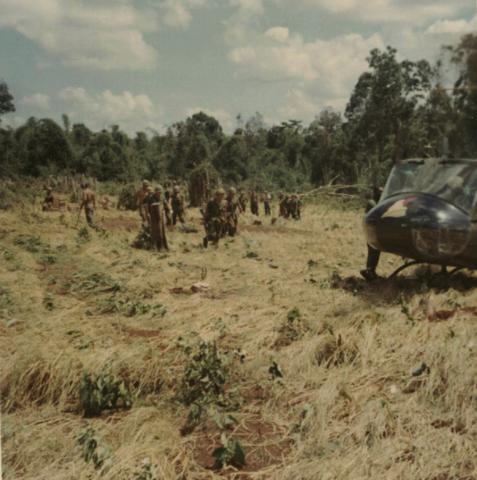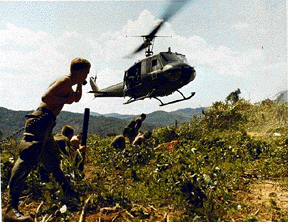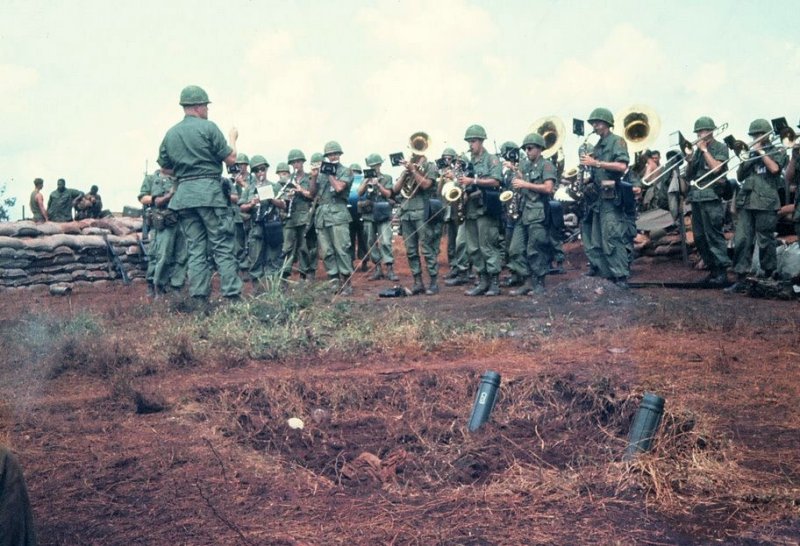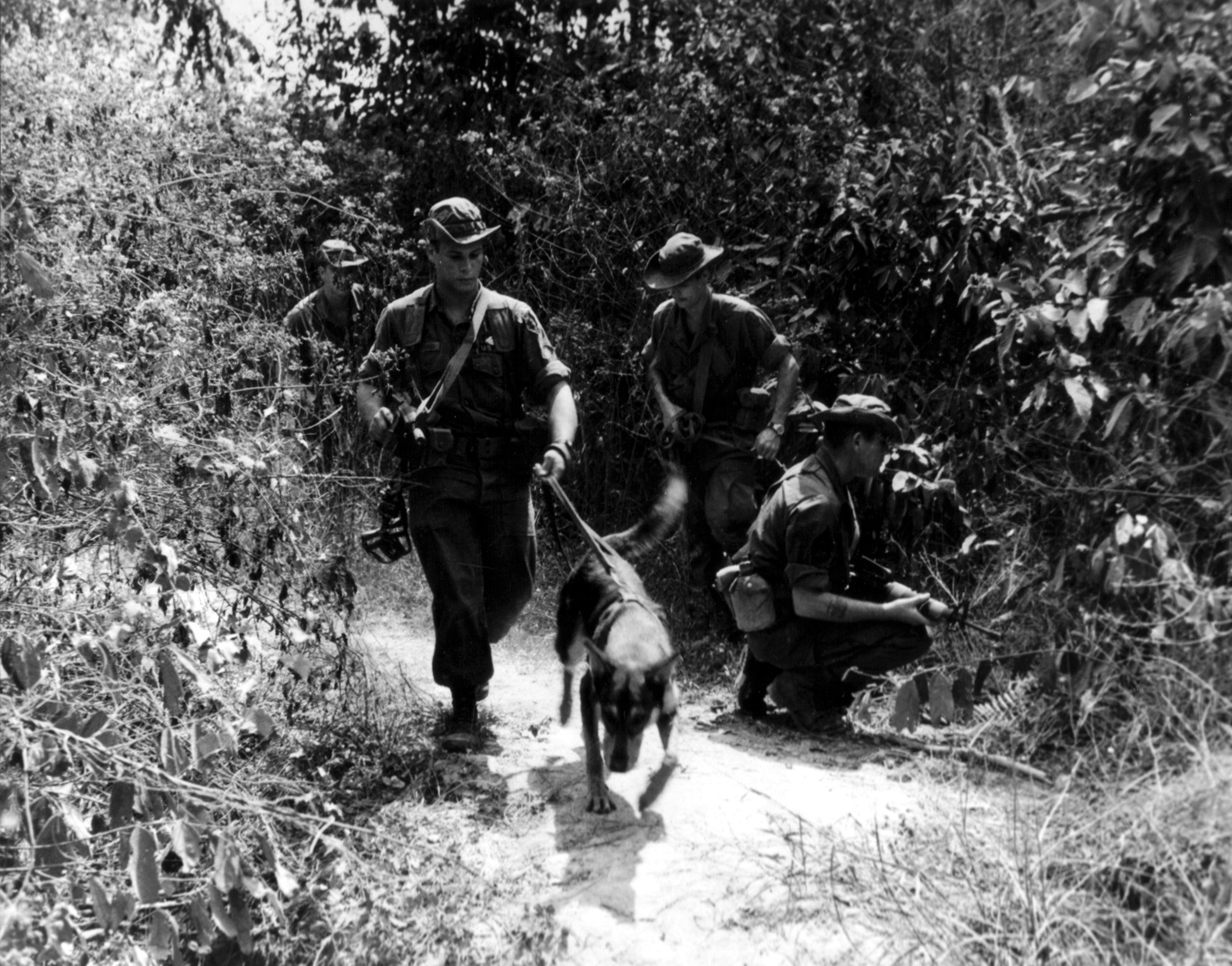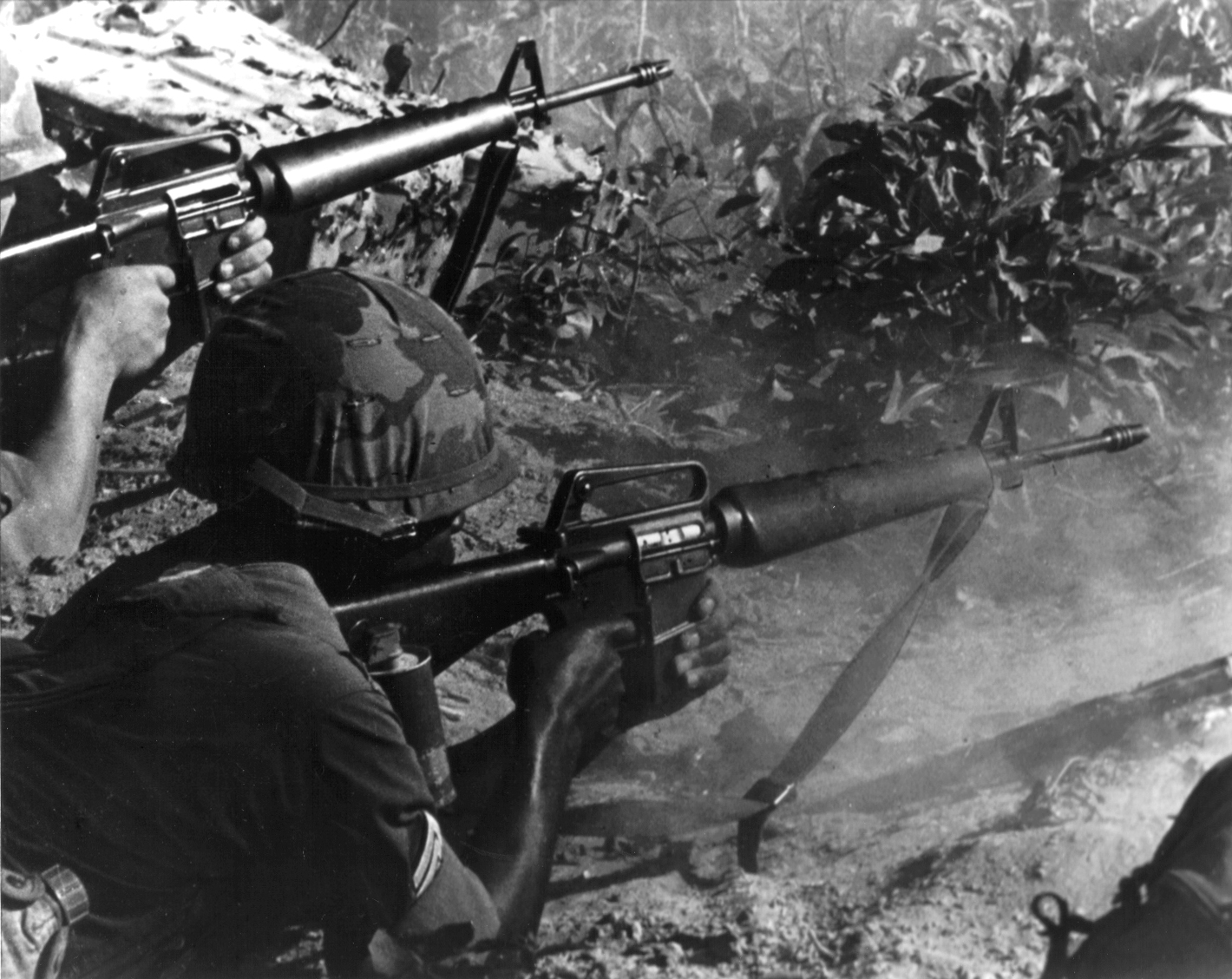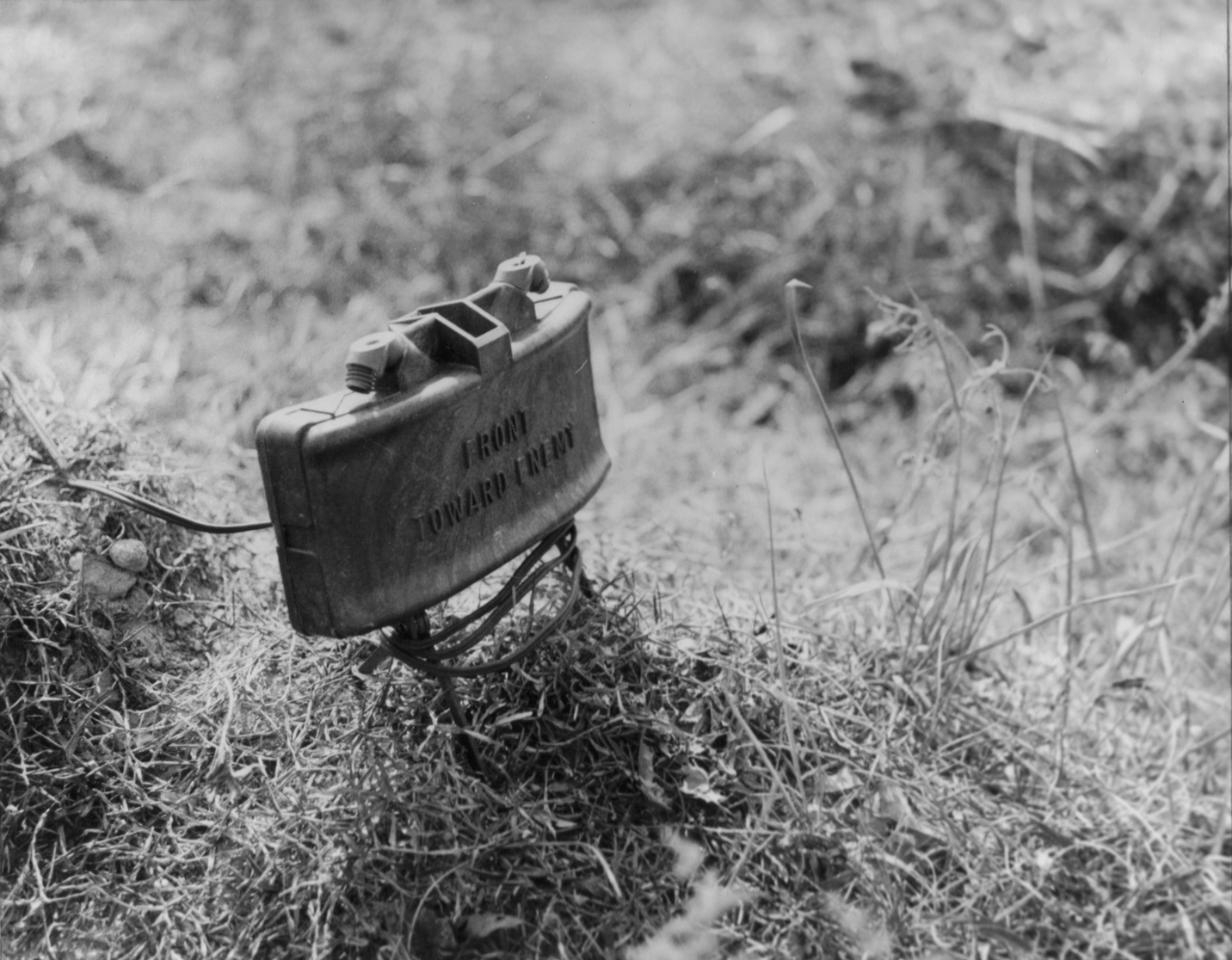
During the weeks that preceded the battle, the headquarters of the 9th Viet Cong Division left War Zone D for the border area north of Loc Ninh. The division headquarters moved with the 273d Viet Cong Regiment and approached the border areas where the 272d Regiment had already assembled. The 271st Regiment, the third of the division's three regiments, moved into the Long Nguyen secret zone, fifty kilometers south of Loc Ninh. A captured enemy document indicated that this move was made to facilitate the logistic support of the 271st Regiment. However, after several contacts with elements of the U.S. 1st Infantry Division, including the battle of Da Yeu, the 271st Regiment withdrew from the area in late October. The regiment had sustained over 400 killed in action during its brief tenure in the Long Nguyen secret zone, and it was probably too weak to be committed at Loc Ninh. The 165th Viet Cong Regiment was subsequently directed to provide additional men to the 9th Division in order to fill in the ranks.
The enemy's scheme of maneuver directed the 272d and 273d Viet Cong Regiments to converge on Loc Ninh. The 272d Regiment was to approach from the northeast and the 273d was to approach from the west, The operation began at 0100 hours on 29 October, when the 273d Regiment attacked the district headquarters and the Civilian Irregular Defense Group (CIDG) and Special Forces camp at the Loc Ninh airfield. The 273d Regiment pressed the attack until 0535 when it was forced to withdraw. Although it had briefly penetrated the CIDG compound, it left 147 Viet Cong bodies on the battlefield. ,
In reaction to the attack, Major General John H. Hay, Jr., commander of the 1st Infantry Division, alerted four battalions and their supporting artillery. General Hay's plan was to deploy the battalions in a rough square around Loc Ninh. A study of the terrain and the pattern of enemy activity in the area revealed the most probable enemy routes of approach and withdrawal. The battalions were to set up night defensive positions at the corners of the square and to block the enemy's withdrawal. Artillery was to be placed in each of the night defensive positions to insure mutual support as well as support for the maneuver battalions' operations. The locations of these positions-temporary fire bases-on routes essential to the enemy would challenge him to attack; and as he massed for the assault, fire from supporting artillery, tactical fighters, and helicopter fire teams would be directed on his exposed formations. In addition to the units along the routes of withdrawal, the plan included bolstering the defenses of Loc Ninh with a small force of infantry and artillery.
At 0630 on 29 October the 1st Battalion, 18th Infantry, commanded by Colonel Cavazos, made an air assault into the southwestern corner of the square, four kilometers west of the Loc Ninh airstrip. Elements of the 2d Battalion, 28th Infantry, commanded by Major Louis C. Menetrey, and two batteries of artillery were moved to the airstrip. The 1st Battalion, 26th Infantry, and the 1st Battalion, 28th Infantry, were moved to Quan Loi, from where they could be committed as the situation developed.
By 1215 the 1st Battalion, 18th Infantry, had made contact with a Viet Cong company. This engagement, the first. of six major firefights that comprised the battle of Loc Ninh, resulted in another twenty-four enemy soldiers killed. At 1215 the following day the 1st Battalion, 18th Infantry, again made contact, and the 273d Viet Cong Regiment lost eighty-three men. At 0055 hours on 31 October, the 272d Viet Cong Regiment made its bid from the northeast for the Loc Ninh district headquarters and the CIDG compound, now reinforced with elements of the 2d Battalion, 28th Infantry, and Battery A, 6th Battalion, 15th Artillery. The 272d Regiment withdrew at 0915, leaving 110 bodies and 68 weapons around the airstrip. To block the withdrawal of the 272d Regiment, the 1st Battalion, 28th Infantry, commanded by Lieutenant Colonel James F. Cochran, III, conducted an air assault three kilometers southeast of the airstrip. Although the battalion made sporadic contact for several days following the assault, it was unable to re-engage the enemy significantly. While the 1st Battalion, 28th Infantry, blocked the southwest withdrawal route of the 272d Regiment, the 1st Battalion, 18th Infantry, searched the area west of the airstrip.
In the early morning hours of 2 November, the night defensive position of the 1st Battalion, 18th Infantry, became the battlefield for the fourth major engagement of the battle for Loc Ninh. The 1st Division's after action report described the conflict as follows:
2 Nov-The 1 /18th Infantry NDP [night defensive position] came under heavy mortar attack commencing at OO80H and lasting for 20 minutes. The mortar positions were reported by ambush patrols, one being directly south of the NDP and one being located to the southwest. About 5 minutes later, Company A ambush patrol reported movement coming from the south. The VC were in the rubber guiding north along a road which led into the NDP. The ambush patrol blew its claymores and returned to the NDP. One VC was KIA [killed in action] attempting to follow the ambush patrol inside the NDP.
To the east, Company D's ambush patrol reported heavy movement and the patrol was ordered to return to the perimeter. Company C ambush patrol located north of the NDP also reported movement. The patrol blew its claymores and returned to the NDP. The VC attacked the NDP from three sides, northeast, east and south. Artillery and mortar defensive concentrations served to blunt the assault. Two VC armed with flamethrowers were killed before their weapons could be fired. As the artillery was brought in close to the NDP from one direction, the VC fire would diminish and build up from another direction.
When LFT's [helicopter light fire teams] arrived on station they were directed to expend on the main attacking force to the south. The gunships as well as the FAC [forward air controller and the AO [aerial observer] received heavy machinegun fire from three locations to the south. Fire from 12 heavy machineguns was identified. Airstrikes eliminated the positions. The artillery battery inside the NDP was directed to be prepared to fire antipersonnel rounds. The guns were readied but their use was not required.
Contact was broken at 0415H. U.S. casualties were 1 KHA [killed hostile action] and 8 WHA [wounded hostile action. There were 198 VC KIA and 22 KBA [killed by air] by body count in the immediate vicinity of the NDP. For the next five days patrols found additional VC bodies bringing the final body count to 263 VC KIA (BC) [body count] and 6 POW's [prisoners of war]. There were 18 individual weapons, 10 crew served weapons, and 3 flamethrowers captured. The flamethrowers were Soviet Model . . . . The unit was identified as the 273d VC Regiment. There were 50 sorties of tactical air flown in support of the contact.
November 2d was the fifth day of the battle for Loc Ninh. The enemy had attacked Loc Ninh twice and had been defeated both times. The U.S. battalions blocking his retreat were deployed on the southeast and southwest withdrawal routes. Intelligence indicated that it was now time to close the escape routes to the north. The 2d Battalion, 12th Infantry (attached to the division for this operation), and the 1st Battalion, 26th Infantry, were assigned the mission. The 2d Battalion, 12th Infantry, commanded by Lieutenant Colonel Raphael D. Tice, air-assaulted seven kilometers northeast of Loc Ninh; the 1st Battalion, 26th Infantry, commanded by Lieutenant Colonel Arthur D. Stigall, landed six kilometers northwest. The landings were unopposed, and both battalions established night defensive positions in the vicinity of their landing zones. The four corners of the square were now occupied by U.S. battalions, each supported by carefully positioned artillery batteries. At 2340 eight Viet Cong walked into the 2d Battalion, 12th Infantry, position, half of them carrying flashlights. Four of the enemy were killed and four were captured. They were members of the 272d Viet Cong Regiment. The U.S. battalion's position was attacked at 0220. When the fight was over, twenty-eight enemy bodies were left around the perimeter.
The final engagement of the battle for Loc Ninh occurred on 7 November, when two companies of the 1st Battalion, 26th Infantry, engaged the 3d Battalion of the 272d Viet Cong Regiment. The 1st Battalion, 26th Infantry, had been airlifted out of the area on 6 November after having spent four days northwest of the airstrip without a significant contact. The battalion air-assaulted into an area two kilometers west of the 2d Battalion, 12th Infantry-roughly eight kilometers northeast of Loc Ninh. The day after the air assault, Companies C and D and Colonel Stigall's command group engaged the 3d Battalion, 272d Regiment. Artillery, armed helicopters, and twenty-seven air strikes supported the U.S. troops. Ninety-three enemy soldiers were killed, including twenty-seven by air strikes. The battle of Loc Ninh was over.
Of the six major engagements that comprised the battle of Loc Ninh, two were fought in temporary night defensive positions. The use of night defensive positions in Vietnam was brought about by the lack of conventional front lines, the inclination of the enemy to fight at night, and the need for the tactical units to protect themselves. The principles of defense were unchanged from earlier wars, but their application to night defensive positions included a number of new techniques. The most widespread of the innovations was the increased emphasis on defensive operations throughout the Army-an army that has been and will probably continue to be oriented to the attack, rather than to the defense. Companies and battalions in previous wars had been integrated into the defensive plans of larger units to a far greater extent than was possible on the battlefields of Vietnam. The independence of these units required a new emphasis on all aspects of defensive operations by company and battalion commanders. For example, in the past a battalion commander in a defensive position on the forward edge of a conventional battle area could expect the brigade headquarters to deploy a security force in front of his position. He could also expect additional forces in the form of a general outpost to be deployed forward of the brigade's outposts. The battlefield in Vietnam, however, was not adaptable to these traditional arrangements, and the extensive security echelons that characterized the night defensive positions in Vietnam were the sole responsibility of the battalion or company commanders who organized the positions.
The principles of defense were professionally applied to the night defensive positions at Loc Ninh. In the 2 November attack on Colonel Cavazos' night position, one American was killed and eight were wounded. The enemy body count was 263. Among the primary factors that contributed to these and other similarly impressive results was the position that had been standardized in the 1st Infantry Division.
(www.history.army.mil/books/Vietnam/tactical/chapter4.htm)
You can also read first hand accounts of this battle in RESEARCH>BATTLE STORIES>LOC NINH 1967
The enemy's scheme of maneuver directed the 272d and 273d Viet Cong Regiments to converge on Loc Ninh. The 272d Regiment was to approach from the northeast and the 273d was to approach from the west, The operation began at 0100 hours on 29 October, when the 273d Regiment attacked the district headquarters and the Civilian Irregular Defense Group (CIDG) and Special Forces camp at the Loc Ninh airfield. The 273d Regiment pressed the attack until 0535 when it was forced to withdraw. Although it had briefly penetrated the CIDG compound, it left 147 Viet Cong bodies on the battlefield. ,
In reaction to the attack, Major General John H. Hay, Jr., commander of the 1st Infantry Division, alerted four battalions and their supporting artillery. General Hay's plan was to deploy the battalions in a rough square around Loc Ninh. A study of the terrain and the pattern of enemy activity in the area revealed the most probable enemy routes of approach and withdrawal. The battalions were to set up night defensive positions at the corners of the square and to block the enemy's withdrawal. Artillery was to be placed in each of the night defensive positions to insure mutual support as well as support for the maneuver battalions' operations. The locations of these positions-temporary fire bases-on routes essential to the enemy would challenge him to attack; and as he massed for the assault, fire from supporting artillery, tactical fighters, and helicopter fire teams would be directed on his exposed formations. In addition to the units along the routes of withdrawal, the plan included bolstering the defenses of Loc Ninh with a small force of infantry and artillery.
At 0630 on 29 October the 1st Battalion, 18th Infantry, commanded by Colonel Cavazos, made an air assault into the southwestern corner of the square, four kilometers west of the Loc Ninh airstrip. Elements of the 2d Battalion, 28th Infantry, commanded by Major Louis C. Menetrey, and two batteries of artillery were moved to the airstrip. The 1st Battalion, 26th Infantry, and the 1st Battalion, 28th Infantry, were moved to Quan Loi, from where they could be committed as the situation developed.
By 1215 the 1st Battalion, 18th Infantry, had made contact with a Viet Cong company. This engagement, the first. of six major firefights that comprised the battle of Loc Ninh, resulted in another twenty-four enemy soldiers killed. At 1215 the following day the 1st Battalion, 18th Infantry, again made contact, and the 273d Viet Cong Regiment lost eighty-three men. At 0055 hours on 31 October, the 272d Viet Cong Regiment made its bid from the northeast for the Loc Ninh district headquarters and the CIDG compound, now reinforced with elements of the 2d Battalion, 28th Infantry, and Battery A, 6th Battalion, 15th Artillery. The 272d Regiment withdrew at 0915, leaving 110 bodies and 68 weapons around the airstrip. To block the withdrawal of the 272d Regiment, the 1st Battalion, 28th Infantry, commanded by Lieutenant Colonel James F. Cochran, III, conducted an air assault three kilometers southeast of the airstrip. Although the battalion made sporadic contact for several days following the assault, it was unable to re-engage the enemy significantly. While the 1st Battalion, 28th Infantry, blocked the southwest withdrawal route of the 272d Regiment, the 1st Battalion, 18th Infantry, searched the area west of the airstrip.
In the early morning hours of 2 November, the night defensive position of the 1st Battalion, 18th Infantry, became the battlefield for the fourth major engagement of the battle for Loc Ninh. The 1st Division's after action report described the conflict as follows:
2 Nov-The 1 /18th Infantry NDP [night defensive position] came under heavy mortar attack commencing at OO80H and lasting for 20 minutes. The mortar positions were reported by ambush patrols, one being directly south of the NDP and one being located to the southwest. About 5 minutes later, Company A ambush patrol reported movement coming from the south. The VC were in the rubber guiding north along a road which led into the NDP. The ambush patrol blew its claymores and returned to the NDP. One VC was KIA [killed in action] attempting to follow the ambush patrol inside the NDP.
To the east, Company D's ambush patrol reported heavy movement and the patrol was ordered to return to the perimeter. Company C ambush patrol located north of the NDP also reported movement. The patrol blew its claymores and returned to the NDP. The VC attacked the NDP from three sides, northeast, east and south. Artillery and mortar defensive concentrations served to blunt the assault. Two VC armed with flamethrowers were killed before their weapons could be fired. As the artillery was brought in close to the NDP from one direction, the VC fire would diminish and build up from another direction.
When LFT's [helicopter light fire teams] arrived on station they were directed to expend on the main attacking force to the south. The gunships as well as the FAC [forward air controller and the AO [aerial observer] received heavy machinegun fire from three locations to the south. Fire from 12 heavy machineguns was identified. Airstrikes eliminated the positions. The artillery battery inside the NDP was directed to be prepared to fire antipersonnel rounds. The guns were readied but their use was not required.
Contact was broken at 0415H. U.S. casualties were 1 KHA [killed hostile action] and 8 WHA [wounded hostile action. There were 198 VC KIA and 22 KBA [killed by air] by body count in the immediate vicinity of the NDP. For the next five days patrols found additional VC bodies bringing the final body count to 263 VC KIA (BC) [body count] and 6 POW's [prisoners of war]. There were 18 individual weapons, 10 crew served weapons, and 3 flamethrowers captured. The flamethrowers were Soviet Model . . . . The unit was identified as the 273d VC Regiment. There were 50 sorties of tactical air flown in support of the contact.
November 2d was the fifth day of the battle for Loc Ninh. The enemy had attacked Loc Ninh twice and had been defeated both times. The U.S. battalions blocking his retreat were deployed on the southeast and southwest withdrawal routes. Intelligence indicated that it was now time to close the escape routes to the north. The 2d Battalion, 12th Infantry (attached to the division for this operation), and the 1st Battalion, 26th Infantry, were assigned the mission. The 2d Battalion, 12th Infantry, commanded by Lieutenant Colonel Raphael D. Tice, air-assaulted seven kilometers northeast of Loc Ninh; the 1st Battalion, 26th Infantry, commanded by Lieutenant Colonel Arthur D. Stigall, landed six kilometers northwest. The landings were unopposed, and both battalions established night defensive positions in the vicinity of their landing zones. The four corners of the square were now occupied by U.S. battalions, each supported by carefully positioned artillery batteries. At 2340 eight Viet Cong walked into the 2d Battalion, 12th Infantry, position, half of them carrying flashlights. Four of the enemy were killed and four were captured. They were members of the 272d Viet Cong Regiment. The U.S. battalion's position was attacked at 0220. When the fight was over, twenty-eight enemy bodies were left around the perimeter.
The final engagement of the battle for Loc Ninh occurred on 7 November, when two companies of the 1st Battalion, 26th Infantry, engaged the 3d Battalion of the 272d Viet Cong Regiment. The 1st Battalion, 26th Infantry, had been airlifted out of the area on 6 November after having spent four days northwest of the airstrip without a significant contact. The battalion air-assaulted into an area two kilometers west of the 2d Battalion, 12th Infantry-roughly eight kilometers northeast of Loc Ninh. The day after the air assault, Companies C and D and Colonel Stigall's command group engaged the 3d Battalion, 272d Regiment. Artillery, armed helicopters, and twenty-seven air strikes supported the U.S. troops. Ninety-three enemy soldiers were killed, including twenty-seven by air strikes. The battle of Loc Ninh was over.
Of the six major engagements that comprised the battle of Loc Ninh, two were fought in temporary night defensive positions. The use of night defensive positions in Vietnam was brought about by the lack of conventional front lines, the inclination of the enemy to fight at night, and the need for the tactical units to protect themselves. The principles of defense were unchanged from earlier wars, but their application to night defensive positions included a number of new techniques. The most widespread of the innovations was the increased emphasis on defensive operations throughout the Army-an army that has been and will probably continue to be oriented to the attack, rather than to the defense. Companies and battalions in previous wars had been integrated into the defensive plans of larger units to a far greater extent than was possible on the battlefields of Vietnam. The independence of these units required a new emphasis on all aspects of defensive operations by company and battalion commanders. For example, in the past a battalion commander in a defensive position on the forward edge of a conventional battle area could expect the brigade headquarters to deploy a security force in front of his position. He could also expect additional forces in the form of a general outpost to be deployed forward of the brigade's outposts. The battlefield in Vietnam, however, was not adaptable to these traditional arrangements, and the extensive security echelons that characterized the night defensive positions in Vietnam were the sole responsibility of the battalion or company commanders who organized the positions.
The principles of defense were professionally applied to the night defensive positions at Loc Ninh. In the 2 November attack on Colonel Cavazos' night position, one American was killed and eight were wounded. The enemy body count was 263. Among the primary factors that contributed to these and other similarly impressive results was the position that had been standardized in the 1st Infantry Division.
(www.history.army.mil/books/Vietnam/tactical/chapter4.htm)
You can also read first hand accounts of this battle in RESEARCH>BATTLE STORIES>LOC NINH 1967

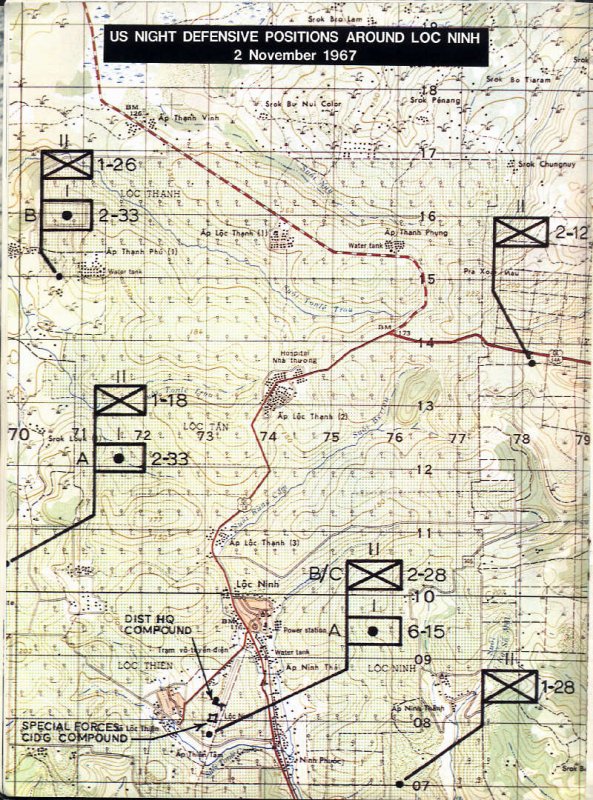
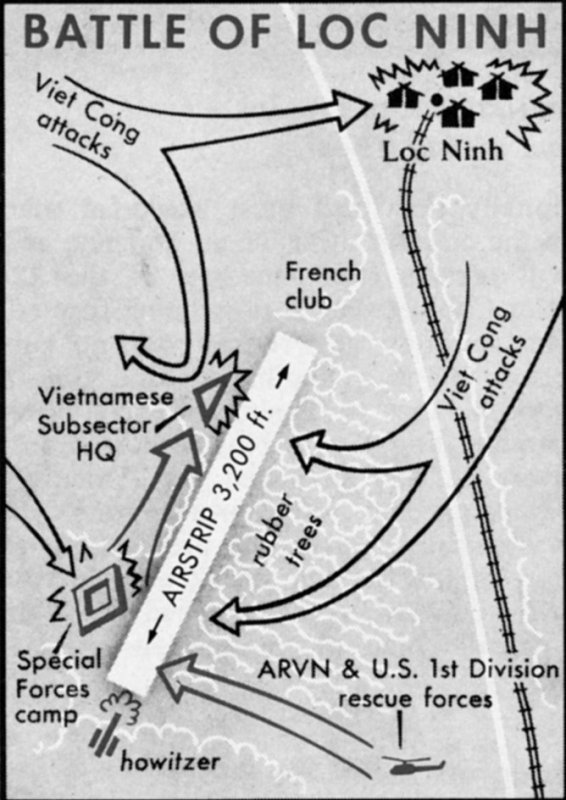
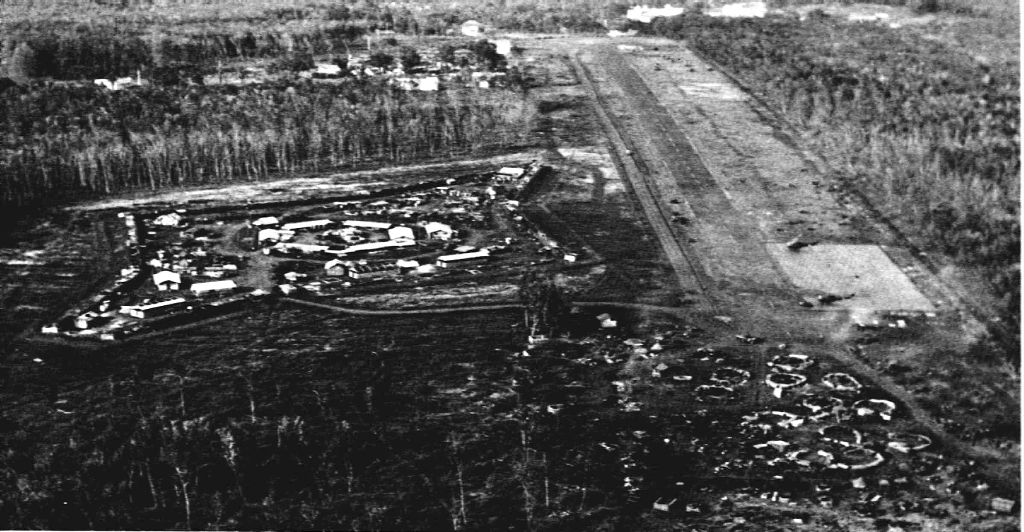
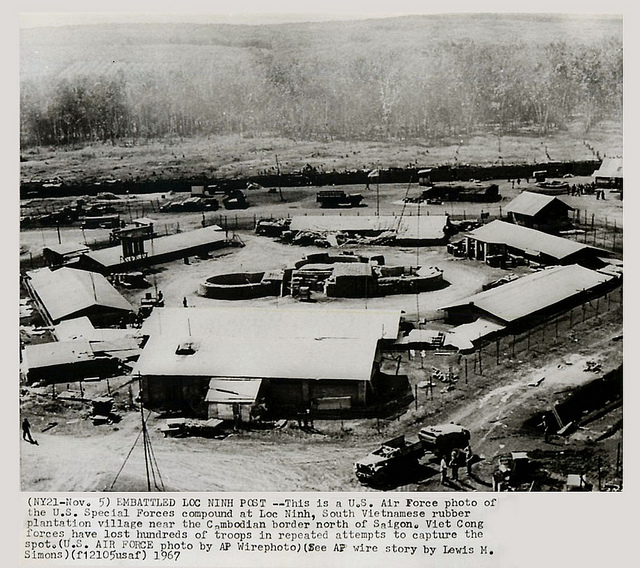
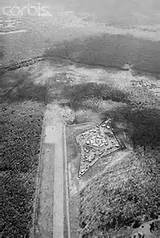


Slide Show - Will run automatically




